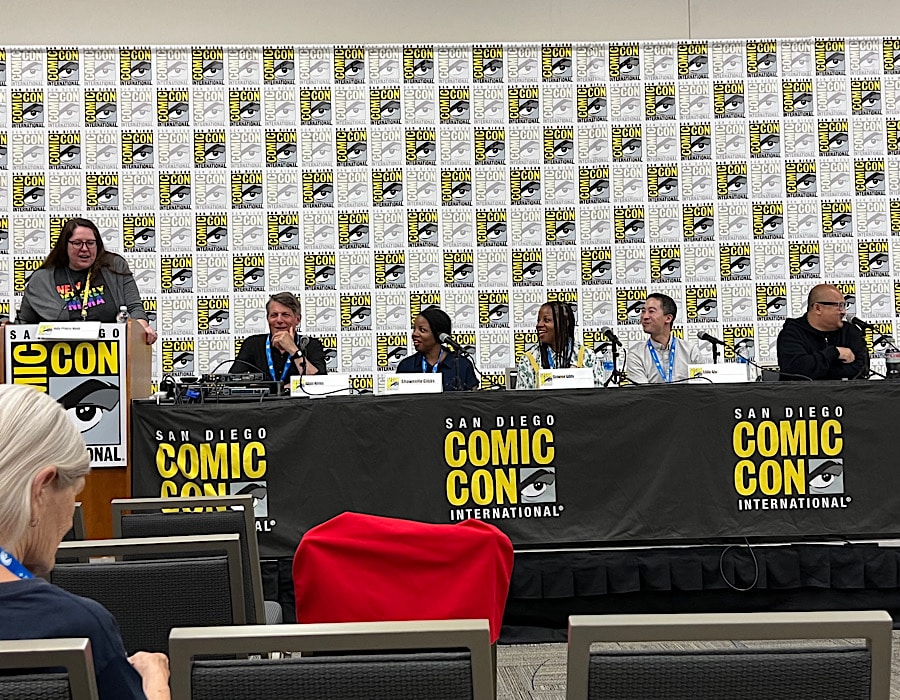Families are complicated, and creators often have to juggle artistic license with revealing truth. On July 27, 2024, Judy Prince-Neeb (youth services librarian, Torrance Public Library) moderated a panel at San Diego Comic-Con that explored what happens when the ties that bind families together begin to fray, tangle, or constrict. Joining Neeb on the panel were Adam Nimoy (The Most Human), Shawnelle and Shawnee Gibbs (Ghost Roast), Eddie Ahn (Advocate) and Thien Pham (Family Style).
Neeb kicked off the discussion by asking panelists to describe their approaches to writing or illustrating a particular story. Nimoy referenced his experiences in a 12-step recovery program, where he anonymously spoke of his estranged relationship with his father, Leonard Nimoy. Fellow 12-steppers were entered.
“It was resonating more and more to the point where they would say, ‘I’m going to call my dad tonight. I’m going to all my estranged mother or sibling,’ And it just felt like I really had more to do, a deeper dive about what happened with my dad,” said Nimoy. “My first memoir ended as we were reconciling. For the last seven years of his life, I was very close to him. “It just like this was the time to dive deeper into that project.”
Ghost Roast was inspired by a New Orleans trip the Gibbs sisters took with their mother. As they danced their way around Congo Square, they discovered that enslaved people often escaped to the square on Sundays to dance. The germ of the idea blossomed with Shawnee, and she began pithing and working on the story with Shawnelle.
Ahn, a San Francisco-based environmental justice attorney had always compartmentalized his career as a nonprofit activist from his interests as an artist. Ahn started creating fictional stories through the do-it-yourself aesthetic of zine culture, but his stories evolved to autobiographical comics. Ahn first published his stories about him in February 2020.

“I thought these comics were for me, very personal stories about how I connected to nonprofit work. Part of it was having a visual pamphlet or some kind of small book I could give my parents,” explained Ahn. “Ultimately, that’s the central conflict in the book; my parents not really caring for my nonprofit work. It wasn’t what they thought I should be doing in my life. It was a very painful experience to try to get them to understand that worldview and that lifestyle I had chosen.”
For Pham, the how of narrating his immigration from Vietnam eluded him. It wasn’t until the pandemic when Pham returned to his parents’ home and learned the truth about that journey.
“My parents are immigrant Asian parents, and one thing about immigrant Asian parents is that they hold a lot of stuff back. They don’t want to worry you about their worries. Never once did we talk about any of their traumas, any of their sadness, any of their difficulties,” said Pham. “So, now I’m old, and my mom is older, too. She finally figured out that okay, I’ll tell this kid my story. And then she told me the story. I was so moved. After half an hour, I was sorry for taking my parents for granted.”
As the months went by, Pham continued to struggle with a storytelling approach. Inspiration finally came from her childhood memories.
“My mom asked, ‘what do you remember about coming to America?’ And I said, ‘I remembered the time you gave me the rice ball when we were on the boat. I remembered when we had that steak.’ And I realized that all my memories were based on food, on the meals I’ve had, and then everything around it. “That was my voice.”
Neeb sought to understand how each panelist balanced the truth that readers receive with the perception of perspective. Shawnelle spoke of developing characters through channeling; a particular character speaks to the sisters as they write. They then let the character speak to readers, who interpret the character based on their own experiences. They soon found that the characters and stories they created through “transcription” resonated with readers.
Pham took an entirely different approach that relied on social media reactions. Family Style was conceived as a daily Instagram comic. Pham would start work on his six panels at 7 AM and end at 7 PM, posting the comic thereafter and waiting for reader reactions. He would then refine subsequent content based on reader input. In this way, Pham was able to edit in real-time before the story was picked up for print.
Ahn, on the other hand, spoke to the difficulty of balancing family perceptions and expectations.
“A large part of the book was essentially my mother grappling with her relationship with her father, my grandfather, and the problem of the Korean War, their own aspirations for mobility in the US A lot of what they did to begin with was impose their views on what the American success was and how it should go,” said Ahn.
Initially, Ahn was worried how his mother, who maintained an Instagram account, would react to reader input and to published reviews of the book. In the end, after the comic and reading the glowing comments, she cried and expressed appreciation for Ahn’s assertive take on the relationship.
“You own the perspective of what you tell in the story, and then hopefully other people around you, especially family members, will understand,” Ahn said.
On the other hand, Nimoy found it difficult to humanize an iconic character known around the world. Although addiction on both sides had led to conflict and estrangement, Nimoy was in conflict about what he could reveal publicly. To get around this sensitive topic, Nimoy hired an editor, who advised how much and what to disclose. The approach they agreed upon was to connect the threads of family history to highlight that generational disconnect. His grandparents’ lack of emotional connection led to his father’s lack of emotional connection with his own children, leading to their estrangement. The struggle to provide for a family of four children while searching for acting work in precious Los Angeles also strained the already fragile family dynamic. Despite this generational trauma, Nimoy struck a reconciliatory tone.
“I was always proud of what I accomplished, and I say that throughout the book,” said Nimoy. “I’m just trying to be honest about what happened to us. We had a transformative relationship. We were able to reconcile. It’s a success story. But there are some things I think you should know about my relationship.”
Neeb then quoted a Kendrick Lamar song “6:16 in LA” as a lead-in to her next question, which asked what these creators and artists had discovered about themselves in their storytelling journeys. Whereas their forte was creating fictional characters, the Gibbs sisters admitted to tapping into the experience of alienation in middle school as a reaction to their status as scholarship kids for Ghost Roast. In the process, the sisters uncovered hereditary roots that stretch upwards from the South,
For Nimoy, the lesson learned was staying in the process as an artist.
“Try to get the work out there. Don’t put stuff off. Don’t meander. It may not be perfect, but it’s still worth it.”
The final rotation of questions ended with Ahn, who reflected on his life and career leading into the publication of Advocate.
“I’m not a young man, and I’m not just starting off with a writing career. I’ve done a lot of different things, but this is the story that needs to be told,” said Ahn. “it’s inspired me to continue on and get stuff out there. “I mean, this is point when you’re hot and you’re on it, you’re feeling the passion, it’s really the best time to put it out in the world.”
Stay tuned for more SDCC ’24 coverage from The Beat.



